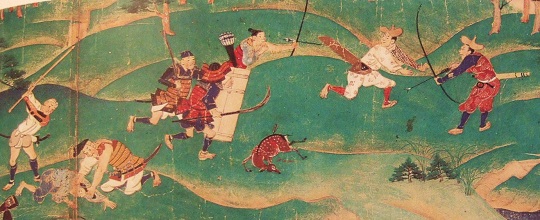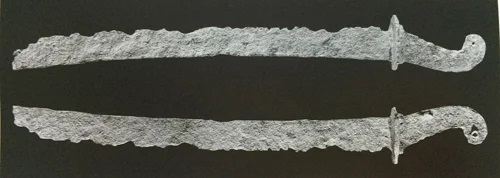Horo (母衣) - Samurai Cape
Horo (母衣) - Samurai Cape
A detail from "一の谷合戦図屏風" where Kumagai Naozane is depicted wearing an Horo on horseback.
The Horo (母衣), also written with the characters 袰, 幌 and 保呂, is a type of Japanese cape associated to the Samurai class.
It is quite unique as a form of cape and it was worn by the Japanese mounted warriors on the battlefield of the Heian and Kamakura period.
It was a mantle-like gear worn on top of the O'yoroi when on horseback. When riding, it was flapping or if tied to the hips, it blew up like a sail and it is assumed that it was worn for threatening the enemy and to enhance the majestic appearance of a mounted warrior.
It was a mantle-like gear worn on top of the O'yoroi when on horseback. When riding, it was flapping or if tied to the hips, it blew up like a sail and it is assumed that it was worn for threatening the enemy and to enhance the majestic appearance of a mounted warrior.
An horo fixed on the back of the armor, from 軍用記 7巻. [3] You can see how the cords were fixed on top of the shoulder area and on the hips.
However, when not being inflated by the wind, the Horo was hanging down in an unsightly manner and so a framework of bamboo or whalebone, the Horo-bone (母衣骨 or 幌骨) was introduced around the 13th/14th century to hold the cloth in its inflated position; as the Horo worn with a Horo-bone had to be larger in size than an ordinary Horo, it was called Ou-horo (大母衣), but normal sized Horo were worn too with this frame.
The cape was fixed with a variable number of cords, from six to twelve.
In the old times, it is recorded that the upper and lower ends of the Horo were bordered with brocade and the centre had either bonji (梵字 - sanskrit characters ) or the name of the wearer.
The cape was fixed with a variable number of cords, from six to twelve.
In the old times, it is recorded that the upper and lower ends of the Horo were bordered with brocade and the centre had either bonji (梵字 - sanskrit characters ) or the name of the wearer.
The Horo-bone frame, a detail from 甲冑着用指南
A normal Horo was around 150 cm in width, and the bigger version was around 300 cm according to the "Aro kassen monogatari” (鴉鷺合戦物語); however it is unlikely that such a big cape was worn on the battlefield.
They came in different colors, which were chosen by the Samurai and although they might be weird from a western perspective, the Horo tell us how these warriors wanted to be recognized on the battlefield.
It is one of the first symbols of a culture that will be fully developed in the Kawari Kabuto; but that's a topic for another article.
To make it simple, the Samurai used a lot of weird looking regalia to be unique, from banners to exotic armors.
They came in different colors, which were chosen by the Samurai and although they might be weird from a western perspective, the Horo tell us how these warriors wanted to be recognized on the battlefield.
It is one of the first symbols of a culture that will be fully developed in the Kawari Kabuto; but that's a topic for another article.
To make it simple, the Samurai used a lot of weird looking regalia to be unique, from banners to exotic armors.
An example of a unfolded Horo, from 軍用記 7巻. [3]
The Horo was also worn during the tumultuos Sengoku Jidai, however the days of mounted archers were ended by few centuries; it is assumed that the ones wearing the Horo were messengers and the cape was a device to be identified by the troops.
It was also worn by generals to highlight their high ranking position within the military hierarchy.
Myths and Misconceptions
If you are familiar with Samurai arms & armors you might already have heard about the "arrow proof" property of this capes; well, it is likely to be a myth.
I was into this myth too but then I realized how this is not properly logic.
The Horo was never meant or intended to be used against arrows; it might work when inflated: being made of silk, which is a resilient material, and whit the pressure of the wind, it could avoid penetration by arrows.
Mike Loads did some test within this context, but the Yumi they were using was probably an extremely low poundage bow, not a great analogy for a warbow.
However, armors are meant to stop arrows and other threats; a cape is just a cape, made for display and for show the warrior's position.
Regarding Samurai armors used in conjunction with the Horo, here are some sketches made by me to show how the Horo wasn't needed to stop arrows from behind;
Here you can see on the left an O'yoroi type of armor (10th - 14th century) and on the right a Tosei Gusoku type of armor (16th century) from the rear, on horseback. Note how protective are the two configurations, especially the O'yoroi, where the two big Osode are fixed behind the wearer's back and cover the entire arm. An Horo won't add much protection in my opinion.
I've also read that the Horo was meant to be used as a flying tool, to allow its user to plane above his enemies when unhorsed... again this might work but I'm quite skeptical about this theory.
Here you can see on the left an O'yoroi type of armor (10th - 14th century) and on the right a Tosei Gusoku type of armor (16th century) from the rear, on horseback. Note how protective are the two configurations, especially the O'yoroi, where the two big Osode are fixed behind the wearer's back and cover the entire arm. An Horo won't add much protection in my opinion.













Thanks you for having made this article. I understand that I was wrong about it. Thank you for sharing me some light on it
ReplyDeleteYou might no be wrong actually; anyway, until recently I was into the myth too.
DeleteWell it is still debated whether or not the Horo was used to stop arrows; potentially it could, as I said, there is a video on you tube where the Horo stopped arrows when inflated by air:
https://www.youtube.com/watch?v=8B_6BU7SYf8
My argument is that at the end of the day, it wasn't a necessity due to armor, especially the Oyoroi; it could still be pierced by a powerful close ranged shot by a bow, and so the Horo might be useful, but generally speaking if someone is chasing you on horseback, you shoot them too as we see in several period paintings. Not to mention that all the references to its arrows proof capabilities are modern and are not found in old sources.
So it could have worked, but that wasn't its main purpose ;)
Speaking of which, any chance you will cover something like the general tactics of the Sengoku armies? I only have some most basic understanding on samurai tactics (i.e. woodpecker tactics) so would like to learn more.
ReplyDeleteI would love to in the near future!! Unfortunately this is not my main field of study but I'll try my best! However there isn't much work done on the subject, a lot of sources are actually from the Edo period and sometimes re-arranged by modern authors so I want to be careful and don't spread further misconceptions!
DeleteAhh, I've read claims that the Woodpecker tactic was more-or-less a work of fiction, as are many of those fancy formations, Nobunaga's three-line arquebus shooting etc.
DeleteTsurinobuse does appear to be a valid and historical "named" tactic though?
It might be, honestly I'm skeptical too especially on the weird formations, but when dealing with Japanese warriors, they were really into "fanciness"; just look at the Horo, the Kawari Kabuto or the fact that they used to paint their horses... so I won't be too surprised if some of those tactics saw real use.
DeleteNagashino is kinda "romanticized" as the whole "Nobunaga + firearms + interest towards European's stuff" equation, there is still a debate about his three line gunners and how they worked.
Tsurinobuse might be valid indeed; the Samurai loved any type of ambushes since the Heian period, in spite of the "heroic duels" that are often associated with them.
Anyway, I've found today an original mid Edo period manual dealing with tactics and strategy, I might look into it and see if there is enough material to write something ;)
Did the Mongols pick up on this technology?
ReplyDeleteHi!
DeleteI wouldn't say so, as far as I am aware I have never seen the Mongols using a horo. It was very much used in Japan like other Japanese regalia and banners (Sashimono etc.)
I remember seeing that too in Sekigahara (2017). Namely there's a part of the movie when Tokugawa Ieyasu works on a Horo and explains to his confidant/lover how he crafted one during his escape through Iga. At one point he even draws a (poetic) comparison between the Horo and the mother's placenta (and indeed the Ho kanji means mother). As for the battle itself, judging from the vibrant colors they seem to be used to differentiate soldiers.
ReplyDeleteIt’s fascinating to learn about different cultural perspectives on warfare and attire.
ReplyDelete